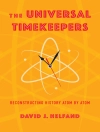This practical guide covers the essential tasks in statistical data analysis encountered in high energy physics and provides comprehensive advice for typical questions and problems. The basic methods for inferring results from data are presented as well as tools for advanced tasks such as improving the signal-to-background ratio, correcting detector effects, determining systematics and many others. Concrete applications are discussed in analysis walkthroughs. Each chapter is supplemented by numerous examples and exercises and by a list of literature and relevant links. The book targets a broad readership at all career levels – from students to senior researchers. An accompanying website provides more algorithms as well as up-to-date information and links.
* Free solutions manual available for lecturers at www.wiley-vch.de/supplements/
Inhoudsopgave
1 Fundamental concepts
Roger Barlow
2 Parameter estimation
Olaf Behnke and Lorenzo Moneta
3 Hypothesis testing
Gregory Schott
4 Interval Estimation
Luc Demortier
5 Classification
Helge Voss
6 Unfolding
Volker Blobel
7 Constrained fits
Benno List
8 How to deal with systematic uncertainties
Rainer Wanke
9 Theory uncertainties
Markus Diehl
10 Statistical methods commonly used in high energy physics
Carsten Hensel and Kevin Kroninger
11 Analysis walk-throughs
Aart Heijboer and Ivo van Vulpen
12 Applications in astronomy
Harrison B. Prosper
Over de auteur
Olaf Behnke is a staff physicist at DESY (Hamburg) and an expert for the physics of heavy quarks. He currently holds the position of physics chair in the ZEUS experiment and has recently also joined CMS.
Kevin Kroninger is working at the University of Gottingen on the ATLAS experiment, with a focus on top-quark physics. He is one of the authors of the Bayesian Analysis Toolkit (BAT).
Thomas Schorner-Sadenius is a staff scientiest at DESY, Hamburg, where he is currently the leader of the Analysis Centre of the German Helmholtz Alliance ?Physics at the Terascale?.
Gregory Schott is a physicist employed at the Karlsruhe Institute of Technology and works on the CMS experiment. His main contributions are in the fi eld of Higgs physics. He is one of the authors of the ROOSTATS software package.











